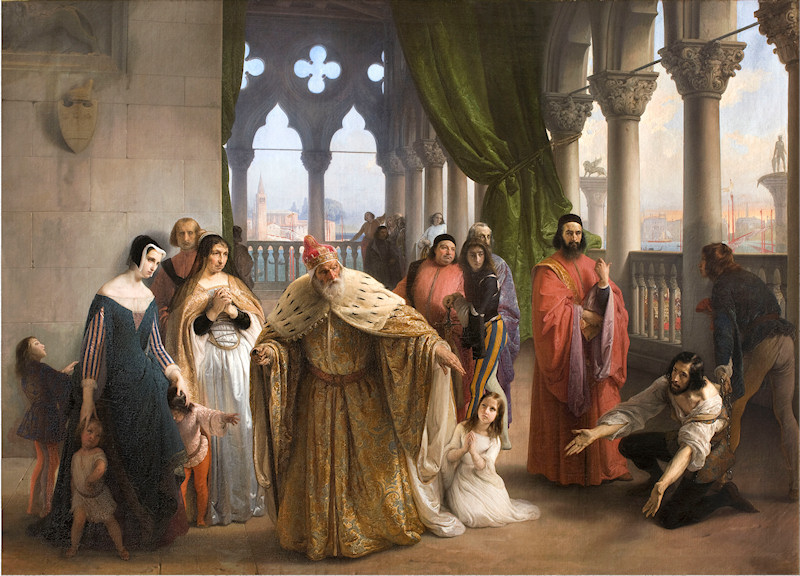Fayl:Artgate Fondazione Cariplo - Hayez Francesco, L'ultimo abboccamento di Giacomo Foscari figlio del doge Giuseppe.jpg
Artgate_Fondazione_Cariplo_-_Hayez_Francesco,_L'ultimo_abboccamento_di_Giacomo_Foscari_figlio_del_doge_Giuseppe.jpg (800 × 576 piksel, fayl hajmi: 176 KB, MIME tipi: image/jpeg)
Ushbu fayl Vikiomborga yuklangan boʻlib, boshqa loyihalarda ham qoʻllanilishi mumkin. Uning tavsif sahifasidan olingan maʼlumot quyida keltirilgan.
Qisqa izoh
| Francesco Hayez: The Last Meeting between Jacopo Foscari and his Family Before Being Sent into Exile
|
||||||||||||||||||||||||||||
|---|---|---|---|---|---|---|---|---|---|---|---|---|---|---|---|---|---|---|---|---|---|---|---|---|---|---|---|---|
| Artist |
artist QS:P170,Q223725 |
|||||||||||||||||||||||||||
| Title |
The Last Meeting between Jacopo Foscari and his Family Before Being Sent into Exile label QS:Lit,"L'ultimo abboccamento di Jacopo Foscari con la propria famiglia (I due Foscari)"
label QS:Len,"The Last Meeting between Jacopo Foscari and his Family Before Being Sent into Exile"
label QS:Lde,"Das letzte Zusammentreffen zwischen Jacopo Foscari und seiner Familie vor der Vertreibung ins Exil" |
|||||||||||||||||||||||||||
| Object type |
rasm object_type QS:P31,Q3305213 |
|||||||||||||||||||||||||||
| Taʼrif |
The painting was commissioned in 1838 by Emperor Ferdinand I, who had arrived in Milan for his coronation as king of Lombardy and Veneto, and it was destined for the Belvedere Gallery in Vienna. On its completion in 1840 the work was valued at the extremely high price of five thousand florins by the Commissione Permanente di Pittura dell’Accademia di Brera, which thus recognized its exceptional quality. In 1928 this large canvas was auctioned at the Galleria Scopinich in Milan, together with other valuable Italian paintings from the imperial collections, where it was bought by Antonio Bernocchi an important member of the rising entrepreneurial middle class, who was active in the textile sector and became senator of the Kingdom of Italy in 1929. The painting entered the Cariplo Collection from this prestigious private collection in 1989. Histoire de la République de Venise by the French historian Pierre Daru is the literary source of this episode regarding the Doge, who was forced to accept that his son Jacopo was sentenced to exile after being unjustly accused of treason. This subject had also been formerly addressed by Lord Byron in 1821 in his tragedy The Two Foscaris, which inspired the opera of the same name in 1844 by Giuseppe Verdi. The critics immediately recognised the theatrical appeal of history painting that often chose the same subjects as the more popular operas. The general public readily identified with the events depicted on canvas because of the precise reconstruction of settings, costumes and gestures, but also because they included portraits of their contemporaries as historical figures. In this canvas in the Collection the Doge is an older self portrait of Hayez himself, and with a dramatic gesture he forces his son to respect the decision of the Council of Ten, as he leans on his stick trembling with emotion. The differing reactions of the figures around him are evident: the silent suffering of the women; the icy expression of Jacopo’s enemy Loredano standing beside him, as the condemned son stretches out his hands towards his father; the various emotions of the children. Jacopo’s leavetaking of his family is rendered even more agonising by the allusion to his imminent departure from his homeland evident in the view of the lagoon with the ships about to set sail, which can be glimpsed through the portico of the Ducal Palace. The myth of Venice and the loneliness of the powerful are condensed in this episode, which Hayez treated repeatedly in several versions, including the famous canvas commissioned by his friend and adviser Andrea Maffei and executed between 1852 and 1854 (Florence, Galleria d’Arte Moderna Palazzo Pitti). The artist’s dramatic sensibility and the similarity between his painting and Verdi’s opera, was further confirmed when he was asked to revise the costume-sketches for the staging of The Two Foscaris in 1858. |
|||||||||||||||||||||||||||
| Depicted people |
Jacopo Foscari |
|||||||||||||||||||||||||||
| Sanasi |
1838 - 1840 date QS:P571,+1850-00-00T00:00:00Z/7,P1319,+1838-00-00T00:00:00Z/9,P1326,+1840-00-00T00:00:00Z/9 |
|||||||||||||||||||||||||||
| Medium |
oil on canvas medium QS:P186,Q296955;P186,Q12321255,P518,Q861259 |
|||||||||||||||||||||||||||
| Dimensions |
balandligi/bo'yi: 165 cm; width: 233 cm dimensions QS:P2048,165U174728 dimensions QS:P2049,233U174728 |
|||||||||||||||||||||||||||
| Collection |
institution QS:P195,Q2054135 |
|||||||||||||||||||||||||||
| Current location |
Italiano: Sezione II |
|||||||||||||||||||||||||||
| Accession number |
AH01833AFC |
|||||||||||||||||||||||||||
| Notes | Elena Lissoni, Artgate Fondazione Cariplo | |||||||||||||||||||||||||||
| References |
|
|||||||||||||||||||||||||||
| Source/Photographer | Artgate Fondazione Cariplo | |||||||||||||||||||||||||||
| Ruxsat (Bu faylning takror foydalanilishi) |
Bu fayl Creative Commons asosida litsenziyalangan Attribution- Share Alike 3.0 Unported litsenziyasi. Attributsiya: Fondazione Cariplo
|
|||||||||||||||||||||||||||
Litsenziyalash
- Siz erkinsiz:
- ulashishga – ishlanmani nusxalash, tarqatish va uzatish
- remiks qilishga – ishni moslashtirishga
- Quyidagi shartlar asosida:
- atribut – Siz tegishli litsenziyaga havolani taqdim etishingiz va oʻzgartirishlar kiritilganligini koʻrsatishingiz kerak. Siz buni har qanday oqilona yoʻl bilan qilishingiz mumkin, lekin litsenziar Sizni yoki Sizning foydalanishingizni ma'qullashini taklif qiladigan tarzda emas.
- bir xil ulashish – Agar Siz materialni remiks qilsangiz, oʻzgartirsangiz yoki unga asoslansangiz, oʻz hissalaringizni asl nusxadagi kabi bir xil yoki mos litsenziya ostida tarqatishingiz kerak.
Captions
Items portrayed in this file
tasvirlangan ob'ekt
collection inglizcha
Art collections of Fondazione Cariplo inglizcha
image/jpeg
checksum inglizcha
f3c89e8d7a2bbd7cc135187a9fd6233c3d4b601b
data size inglizcha
179 978 Bayt
576 piksel
width inglizcha
800 piksel
Fayl tarixi
Faylning biror paytdagi holatini koʻrish uchun tegishli sana/vaqtga bosingiz.
| Sana/Vaqt | Miniatura | Oʻlchamlari | Foydalanuvchi | Izoh | |
|---|---|---|---|---|---|
| joriy | 10:36, 9-Sentyabr 2011 |  | 800 × 576 (176 KB) | M.casanova |
Fayllarga ishoratlar
Bu faylga quyidagi sahifa bogʻlangan:
Faylning global foydalanilishi
Ushbu fayl quyidagi vikilarda ishlatilyapti:
- ar.wikipedia.org loyihasida foydalanilishi
- de.wikipedia.org loyihasida foydalanilishi
- en.wikipedia.org loyihasida foydalanilishi
- eo.wikipedia.org loyihasida foydalanilishi
- fr.wikipedia.org loyihasida foydalanilishi
- it.wikipedia.org loyihasida foydalanilishi
- it.wikibooks.org loyihasida foydalanilishi
- lt.wikipedia.org loyihasida foydalanilishi
- nl.wikipedia.org loyihasida foydalanilishi
- ru.wikipedia.org loyihasida foydalanilishi
- sh.wikipedia.org loyihasida foydalanilishi
- sr.wikipedia.org loyihasida foydalanilishi
- sv.wikipedia.org loyihasida foydalanilishi
- www.wikidata.org loyihasida foydalanilishi



